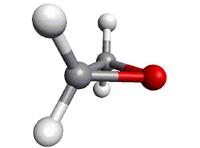Oxirane, ethylene oxide, oxa-cyclopropane, doubly deuterated at C2
 | |
|---|---|
| Species tag | 046533 |
| Version | 1* |
| Date of Entry | Apr 2023 |
| Contributor | H. S. P. Müller |
|
The transition frequencies were published by | |
| Lines Listed | 23566 |
| Frequency / GHz | < 3000 |
| Max. J | 74 |
| log STR0 | -9.0 |
| log STR1 | -7.5 |
| Isotope Corr. | |
| Egy / (cm–1) | 0.0 |
| µa / D | 0.50 |
| µb / D | 1.81 |
| µc / D | |
| A / MHz | 23062.787 |
| B / MHz | 18013.451 |
| C / MHz | 12727.736 |
| Q(300.0) | 12072.1583 |
| Q(225.0) | 7840.0807 |
| Q(150.0) | 4267.8572 |
| Q(75.00) | 1510.3132 |
| Q(37.50) | 535.2668 |
| Q(18.75) | 190.2151 |
| Q(9.375) | 67.9527 |
| Q(5.000) | 26.9549 |
| Q(2.725) | 11.2072 |
| detected in ISM/CSM | tentatively |